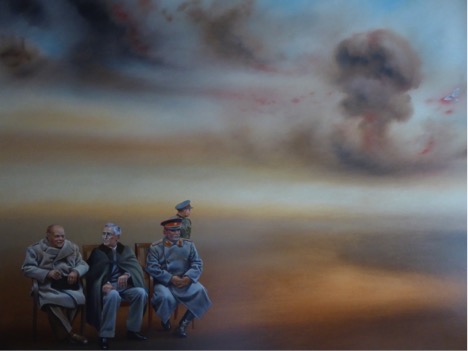“May you live in interesting times.”
Many Americans coming to Europe are lured by the romance: fountains in Rome, cafés in Paris, Spanish guitars, the cool vibes of Berlin. All those existed in the nineteen twenties and early thirties too, though now as then there is something else in the air. It is not featured in any of the very attractive four-color brochures put out by tourist agencies. Indeed, one won’t see, hear, feel, or taste it if one only has a few hours off the cruise ship, or if the itinerary has one shuttling between airport and hotel as fast as one can shout “Next!” But slow down enough to look between the monuments and landmarks and it’s here: Fear. Like a dash of Tabasco in the soup, it is giving life here in Europe an unexpected edge these days. A little bite to the brew.
Headlines suddenly are chockablock with all the worrying details – religious, geopolitical, financial. Currency and debt crises, rise of the Left in the south, rise of the Right in the north, ISIL, Crimea, political assassinations and censorship, calls for Jews to leave Europe. Yesteryear not so yester as one would like. From Georgia to Ukraine to Transnistria, from Dresden to Paris to Denmark and beyond, the pendulum is swinging once again, more wildly than it has for the last quarter century. And the question looms: Will it get worse?
From The New York Times on March 14: “Poles Steel for Battle Fearing Russia Will March on Them Next.” The article quotes one Polish academic: “Worries are increasing but they have not yet reached the level of mass fear.” That same day from CNN: “US Admiral Raises Alarm Over Russian Military Threat.” And, again from The New York Times on March 16, this gem: “Putin Says He Weighed Nuclear Alert Over Crimea.”
Is this what it was like in the thirties? A nice day in Europe, shopping, friends, walks through the park as somewhere a whisper grows into a shout, small articles become banner headlines, then suddenly the sound of glass breaking…and worse.
In the illustration that accompanies this post, the Russian painter Genia Chef (long emigrated to the West) shows Churchill, Roosevelt, and Stalin at the Yalta conference in Crimea, February 1945. A soldier standing behind Stalin is glancing toward the background where one of several clouds drifting by is taking on the shape of a mushroom, as a white dove in flight appears frightened.
This century is fast approaching its own twenties. Instead of a new age however, things are starting to feel a bit too familiar here. Let’s hope that Genia Chef’s painting is not too prescient.

19,231 Total Views, 7 Views Today






